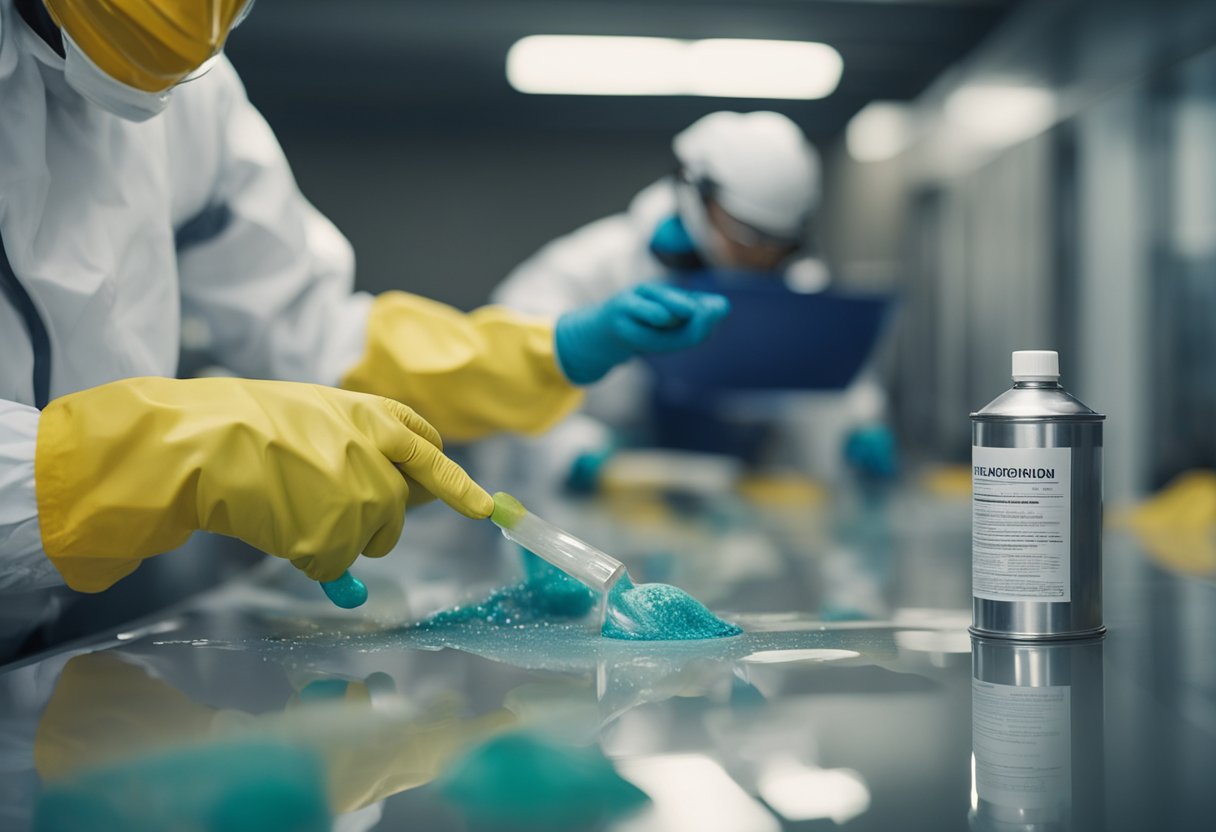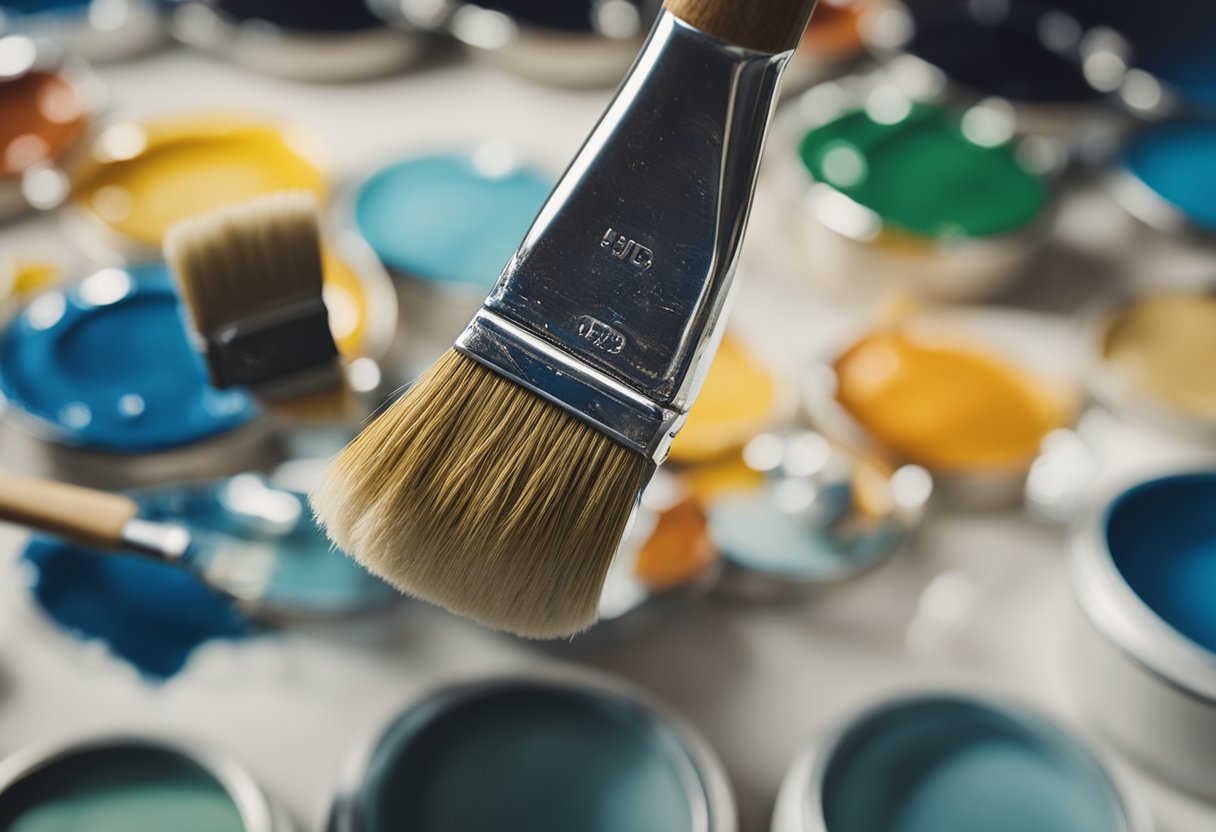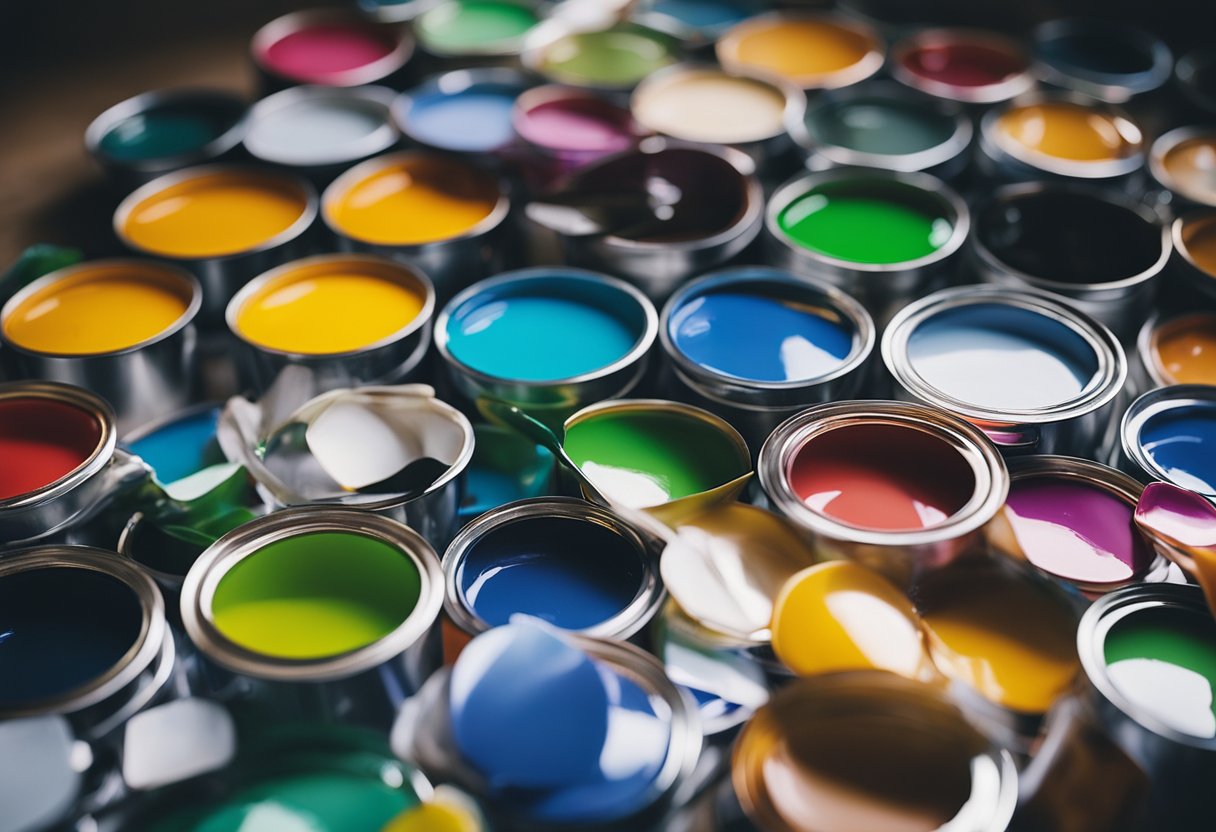As a painter, you may have encountered the dilemma of whether to apply acrylic over enamel paint. While both types of paint have their own unique characteristics and uses, it is important to understand the compatibility and preparation required before applying one over the other. In this article, I will discuss the key factors to consider when using acrylic over enamel paint and provide some tips and techniques to help you achieve the best results.

Acrylic paint is a water-based paint that dries quickly and is easy to clean up with water. Enamel paint, on the other hand, is an oil-based paint that provides a durable and glossy finish. While acrylic paint can be applied over enamel paint, it is important to note that the different chemical compositions and drying properties of the two paints can lead to adhesion issues if not properly prepared. In the following sections, I will discuss the steps you need to take to ensure a successful application of acrylic over enamel paint.
Key Takeaways
- Understanding the differences between acrylic and enamel paint is crucial for achieving a successful application.
- Proper preparation, including cleaning, sanding, and priming, is essential for ensuring adhesion and durability.
- Applying thin layers of acrylic paint and using a suitable topcoat can help achieve a smooth and long-lasting finish.
Understanding Acrylic and Enamel Paint
As a painter, it’s essential to understand the differences between acrylic and enamel paint. Both are popular paint types, but they differ in their chemical composition, drying time, and application.
Acrylic paint is a water-based paint that contains acrylic polymer emulsion. It dries quickly, has a matte finish, and is easy to clean up with soap and water. Acrylics are versatile and can be used on a variety of surfaces, including canvas, wood, and metal. They are also popular for their vibrant colors and long-lasting finish.
On the other hand, enamel paint is an oil-based paint that dries to a hard, glossy finish. It is durable and resistant to wear and tear, making it ideal for high-traffic areas like doors and trim. Enamel paints come in both oil-based and water-based formulas. Oil-based enamel paint is more durable than water-based enamel paint, but it takes longer to dry and has a strong odor. Water-based enamel paint is easier to clean up and dries faster, but it is less durable than oil-based enamel paint.
One of the main differences between acrylic and enamel paint is their drying time. Acrylic paint dries faster than enamel paint, which means that you can apply multiple layers of paint in a shorter amount of time. Enamel paint takes longer to dry, so you need to wait before applying additional coats.
Another difference is the application process. Acrylic paint can be applied with a brush, roller, or spray gun. Enamel paint can also be applied with a brush or roller, but it is thicker and more challenging to apply evenly.
If you need to remove enamel paint, you can use a chemical-based paint stripper. However, acrylic paint can be removed with soap and water or a mild solvent.
In summary, acrylic and enamel paint are two popular paint types that differ in their chemical composition, drying time, and application. Acrylic paint is a water-based paint that dries quickly, while enamel paint is an oil-based paint that dries to a hard, glossy finish. Understanding the differences between these two paint types can help you choose the right paint for your project.
Preparation for Painting
Before applying acrylic paint over enamel, it is crucial to prepare the surface properly. The preparation process ensures that the acrylic paint adheres well to the enamel paint and provides a smooth finish. Here are the steps to follow:
Step 1: Clean the Surface
Clean the surface thoroughly using a degreaser to remove dirt, grease, and other contaminants. Use a clean rag to wipe the surface and remove any remaining residue.
Step 2: Sand the Surface
Use fine-grit sandpaper to sand the surface lightly. Sanding the surface helps to create a rough surface that allows the primer to adhere well. Sanding also helps to remove any gloss or shine from the enamel paint.
Step 3: Apply Primer
Applying a primer is essential to ensure that the acrylic paint adheres well to the surface. Use a latex primer or an enamel primer, depending on the type of surface you are painting. If you are painting a metal surface, use an oil-based primer. Apply the primer with a brush or roller and let it dry completely.
Step 4: Apply Acrylic Paint
After the primer has dried, you can apply the acrylic paint. Use a brush or roller to apply the paint evenly. You can thin the paint with water or a medium to achieve the desired consistency.
Step 5: Seal the Finish
Once the acrylic paint has dried, you can seal the finish with a clear coat. The clear coat helps to protect the surface from scratches and other damage.
By following these steps, you can ensure that the acrylic paint adheres well to the enamel paint and provides a smooth finish. Proper surface preparation is essential to ensure good paint adhesion and a long-lasting finish.
Application and Techniques
When it comes to applying acrylic paint over enamel, there are a few techniques to keep in mind to ensure a successful paint job. First and foremost, it’s important to prepare the surface properly before applying any coat of paint. This includes cleaning the surface thoroughly and sanding it to create a rough texture that will help the paint adhere better.
Once the surface is ready, it’s time to start applying the paint. It’s recommended to apply thin coats of paint rather than one thick coat, as this will help the paint dry faster and reduce the chances of drips and runs. It’s also important to use the right tools, such as a synthetic bristled brush, to ensure a smooth and even application.
When painting over enamel paints, it’s important to note that the drying time and curing time of the paint may be longer than usual. This is because enamel paint is generally slower to dry and cure than acrylic paint. Therefore, it’s important to be patient and allow the paint to dry completely before applying another coat or handling the painted surface.
Overall, applying acrylic paint over enamel requires some preparation and patience, but with the right techniques and tools, it can be done successfully. Remember to apply thin coats, use the right tools, and allow the paint to dry completely before handling the surface.
Finishing and Topcoats
When it comes to finishing and topcoats for acrylic over enamel paint, there are several options to choose from. The type of finish you choose will depend on your personal preference and the type of project you are working on.
If you want a glossy finish, you can use a topcoat that contains urethane. This will give your project a high-gloss finish that is both durable and long-lasting. It is important to note that if you are using a glossy topcoat, you will need to remove the glossy topcoat from the enamel paint before applying the acrylic paint. This can be done by sanding the finish and applying a primer.
If you prefer a matte finish, you can use a topcoat that is specifically designed for matte finishes. This will give your project a smooth, flat finish that is perfect for certain types of projects.
Lacquer paints can also be used as a topcoat for acrylic over enamel paint. Lacquer paints are known for their durability and high-gloss finish. However, it is important to note that lacquer paints can be difficult to work with and require a lot of skill and experience to apply correctly.
Varnish is another option for a topcoat. Varnish is a clear, protective coating that is perfect for protecting your project from scratches, dings, and other types of damage. It is important to note that varnish can be difficult to apply and may require several coats to achieve the desired level of protection.
Overall, there are many options to choose from when it comes to finishing and topcoats for acrylic over enamel paint. It is important to choose the right type of finish for your project and to apply it correctly to ensure a long-lasting, durable finish.
Durability and Longevity
When it comes to choosing between acrylic and enamel paint, one of the most important factors to consider is the durability and longevity of the paint. In general, enamel paint tends to be more durable than acrylic paint. This is because enamel paint is oil-based, which means it dries to a hard, durable finish that is resistant to wear and tear.
However, this does not mean that acrylic paint is not durable. Acrylic paint is water-resistant and can withstand a certain amount of wear and tear. It is also less likely to peel than enamel paint. Additionally, acrylic paint has the advantage of drying faster than enamel paint, which means that it can be recoated more quickly.
When it comes to painting over enamel paint with acrylic paint, it is important to prepare the surface properly to ensure good adhesion. This typically involves cleaning the surface thoroughly and sanding it lightly to create a rougher surface that the acrylic paint can adhere to.
In terms of longevity, both acrylic and enamel paints can last for many years if they are applied and maintained properly. However, enamel paint may be more susceptible to yellowing over time, especially if it is exposed to sunlight. Acrylic paint, on the other hand, is less likely to yellow and can maintain its color for longer.
Overall, both acrylic and enamel paints have their advantages and disadvantages when it comes to durability and longevity. The choice between the two will depend on the specific needs of the project and the conditions the paint will be exposed to.
Cleanup and Safety Measures

As with any painting project, safety should always be a top priority. When working with acrylic and enamel paints, it is important to take extra precautions to protect yourself and your work area. Here are some tips for easy cleanup and safety measures:
Use Rubbing Alcohol for Easy Cleanup
When working with acrylic and enamel paints, it is important to have the right tools for easy cleanup. Rubbing alcohol is a great solution for cleaning up both acrylic and enamel paints. Simply apply a small amount of rubbing alcohol to a clean cloth and gently wipe away any excess paint.
Use Turpentine or Paint Thinner for Solvent-Based Enamel Paints
If you are working with solvent-based enamel paints, you will need to use a stronger solvent for cleanup. Turpentine or paint thinner can be used to clean up solvent-based enamel paints. However, it is important to use these solvents in a well-ventilated area and to wear protective gloves and eyewear.
Take Extra Precautions for Toxicity
Some types of enamel paints can be toxic, so it is important to take extra precautions when working with them. Always read the label and follow the manufacturer’s instructions for safe use. If you are working with toxic enamel paints, wear a respirator mask and protective clothing to avoid inhaling any toxic fumes or getting the paint on your skin.
Properly Dispose of Paint and Solvents
When you are finished with your painting project, it is important to properly dispose of any leftover paint and solvents. Check with your local waste management facility for guidelines on how to safely dispose of these materials. Do not pour paint or solvents down the drain or throw them in the trash.
By following these easy cleanup and safety measures, you can ensure a successful and safe painting project with acrylic and enamel paints.
Cost and Versatility

When it comes to choosing between acrylic and enamel paint, one of the factors to consider is cost. Acrylic paint is generally more affordable than enamel paint, making it a popular choice for those on a budget. This is especially true when you consider that acrylic paint requires fewer coats than enamel paint, which means you’ll need less of it to cover the same surface area.
In addition to being cost-effective, acrylic paint is also incredibly versatile. It can be used on a variety of interior surfaces, including walls, furniture, cabinets, and trim. This makes it a great option for those who want to update their home’s look without breaking the bank.
One of the benefits of using acrylic paint is that it dries quickly, which means you can apply multiple coats in a single day. This is particularly useful when you’re working on a large project, such as painting an entire room or a piece of furniture. Additionally, acrylic paint is available in a wide range of colors and finishes, including matte, satin, and gloss.
While enamel paint is known for its durability and resistance to chipping and fading, it can be more expensive than acrylic paint. Enamel paint is also more difficult to work with, as it requires more coats and a longer drying time. However, if you’re looking for a paint that will stand up to heavy use and last for years, enamel paint may be the better choice.
Overall, when it comes to cost and versatility, acrylic paint is the clear winner. It’s affordable, easy to work with, and can be used on a variety of surfaces. Whether you’re a DIY enthusiast or a professional painter, acrylic paint is a great option for your next project.
Testing and Compatibility

When it comes to painting acrylic over enamel, testing the compatibility of the two paints is crucial. Before starting any painting project, it is important to test a small inconspicuous area to ensure that the two paints are compatible. This can be done by applying a small amount of acrylic paint over the enamel paint and observing it for any signs of peeling, cracking, or flaking. If the acrylic paint adheres well to the enamel paint, then it is safe to proceed with the project.
The substrate on which the paint is applied also plays a crucial role in determining the compatibility of acrylic paint with enamel paint. Enamel paint is known for its durability and can be used on a variety of surfaces, including wood, metal, and plastic. However, not all substrates are compatible with acrylic paint. Some surfaces may require a primer or other preparation to ensure that the acrylic paint adheres well.
Blending the two paints is also important to ensure that the final result looks seamless. One way to achieve this is to use a blending medium that is specifically designed for use with acrylic paint. This medium can be used to blend the acrylic paint with the enamel paint to create a smoother, more even finish.
The binder and paint pigments in both acrylic and enamel paints can also affect compatibility. While both paints use different binders, they can still be compatible if the right preparation is done. Drying time and curing time are also important factors to consider when painting acrylic over enamel. Acrylic paint dries quickly, while enamel paint takes longer to dry and cure. It is important to wait until the enamel paint is fully cured before applying acrylic paint to ensure that the two paints bond well together.
In summary, testing the compatibility of acrylic paint with enamel paint is crucial before starting any painting project. The substrate, blending, binder, paint pigments, drying time, and curing time are all important factors to consider to ensure a successful project.
Frequently Asked Questions

How can I paint over enamel paint without sanding?
Painting over enamel paint without sanding requires preparation. You can use a deglosser or a liquid sandpaper solution to clean and etch the surface of the enamel paint. This will create a surface that is ready to accept a new coat of paint. After applying the deglosser, allow it to dry completely before painting over it with acrylic paint.
What is the difference between enamel and acrylic automotive paint?
Enamel automotive paint is oil-based and has a glossy finish. It is durable and resistant to scratches and chips. Acrylic automotive paint, on the other hand, is water-based and has a matte finish. It is easier to apply and dries faster than enamel paint. Acrylic paint is also more environmentally friendly than enamel paint.
What is the purpose of acrylic enamel paint?
Acrylic enamel paint is a water-based paint that has the durability and hardness of traditional oil-based enamel paint. It is used in a variety of applications, including automotive painting, furniture painting, and home decor. Acrylic enamel paint is resistant to fading, chalking, and peeling, making it a popular choice for outdoor projects.
Can I use acrylic clear coat over enamel paint?
It is not recommended to use acrylic clear coat over enamel paint. The different chemical compositions and drying properties of the two paints can lead to adhesion issues. It is advisable to either remove the enamel paint or apply a suitable primer before painting with acrylics.
Can I use enamel and acrylic paint on the same model?
Yes, you can use enamel and acrylic paint on the same model. However, it is important to use a primer that is compatible with both types of paint to ensure that the paint adheres properly. It is also important to allow sufficient drying time between coats to prevent cracking or peeling.
Is it possible to use acrylic varnish on enamel paint?
Yes, it is possible to use acrylic varnish on enamel paint. However, it is important to ensure that the enamel paint is completely dry and cured before applying the varnish. It is also important to use a varnish that is compatible with both types of paint to ensure that the varnish adheres properly.

Hi, I’m Sal Muller of Tooltrip.com. My DIY experience led me to understand essential power tools for home projects. Tooltrip.com guides enthusiasts and professionals in choosing right tools for any job. I provide concise top tool reviews for easier, efficient DIY.

